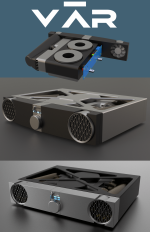Hot beer?What if we place the amps in a refrigerator?
I already installed the fans, without the fan, the heat sink temp is 50c, now, the heatsink is just warm to the touch, just like a class D amp 🙂 I used four 4 inch CPU fans, virtually no noise as each one is relatively weak, but using four is enough to cool the amp to Class D levels.
Do you have to run the AC to cool the room?
Hot beer?
Ugh! That will certainly be the end of the experiment.
OTOH, I dare say the fridge will make a racket, enough to cover up the results of the experiment.
That's an interesting find. I perked up at the uniform device cooling issue and was surprised to see ducted geometries being discussed. I am currently working on a duct system for the long narrow Pass amp boards that are meant for 2U chassis dimensions. At the moment I'm tweaking things to fit two fans per duct in hopes of facilitating the high power F5 versions aside from several other changes. The main concept being each device gets it's own fresh and evenly displaced airflow.Continuous Power per channel both channels driven 20 Hz to 20 kHz 2 ohms: 800 Watts
View attachment 1052291
View attachment 1052292
View attachment 1052293
_________________________________________________________________________
Peavy:
"A classic problem when using forced air to cool a multiplicity of devices arrayed along a heat tunnel is to equalize the device temperatures along the length of the heat tunnel. In high-power amplifiers you routinely use several power devices in parallel. If one receives less cooling than the others, it will run hotter. Like the weak link in a chain, it will reach its maximum temperature and fail first.
Even if all of the power devices have the exact same access to the cooling air- flow, the air picks up heat as it passes over preceding devices. This hotter air can't absorb heat as readily as the cool air. The classic solution for equalizing the thermal gradient in a heat tunnel is to tune the length of the heat sink fingers. Just look inside the industry standard CS800X, The heat sink at the hot, exit end of the heat tunnel has much more aluminium and longer fingers than the cool inlet end.
Multi-stage, graduated-heat tunnels are complex and difficult to manufacture. Our new heat sink approach is deceptively simple. By angling two heat sink extrusions toward each other, forming a truncated "V", the heat transfer is significantly increased at the narrow end.
View attachment 1052297
The cool ambient air enters at the wide end, top of the "V." As the cool air moves through the heat tunnel gaining heat, the walls move closer together increasing air flow and velocity across the fins and helping the hotter air extract the same amount of heat the cooler air did in the previous section. By the time the hottest air gets to the end of the tunnel, the heat transfer is at it's maximum. The net result of tuning the heat sink for air temperature, the devices all operate at close to the same temperature and the amplifier will be able to do more work before the hottest power device gets too hot."
Attachments
You guys are over the target--I'm taking notes lol!Don't forget to open both flaps, on either side....
View attachment 1114406
God bless him... those were the good times!
- Home
- Amplifiers
- Pass Labs
- Forced cooling a class A amp



 It's true!
It's true!